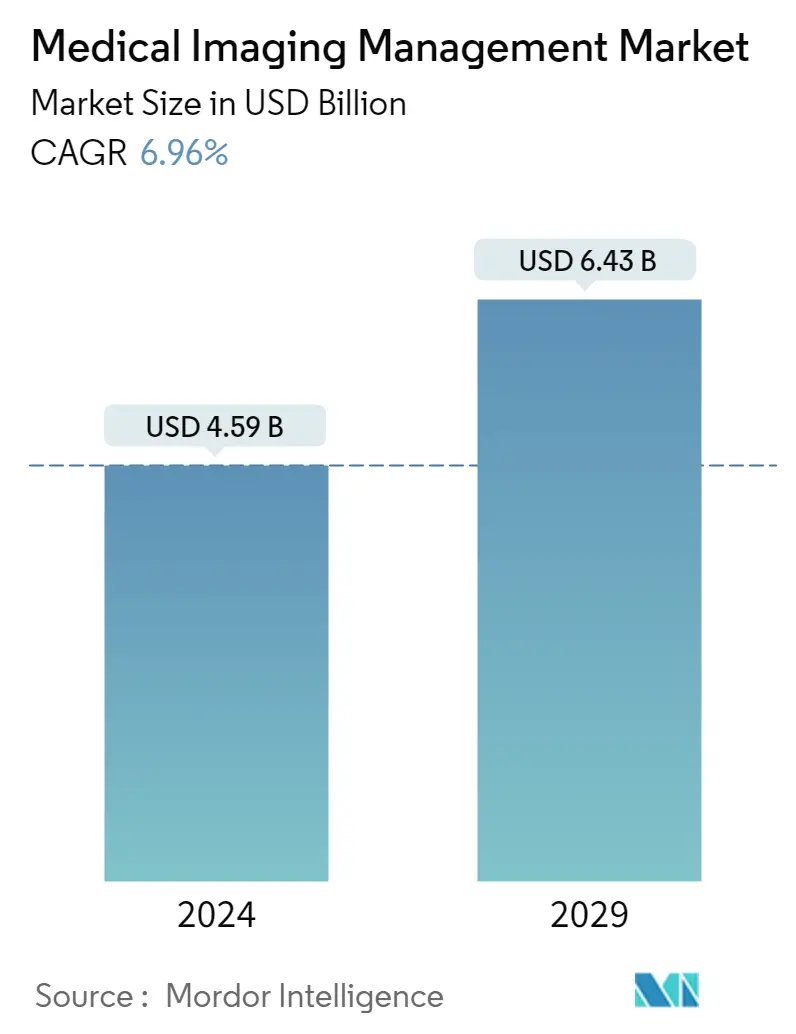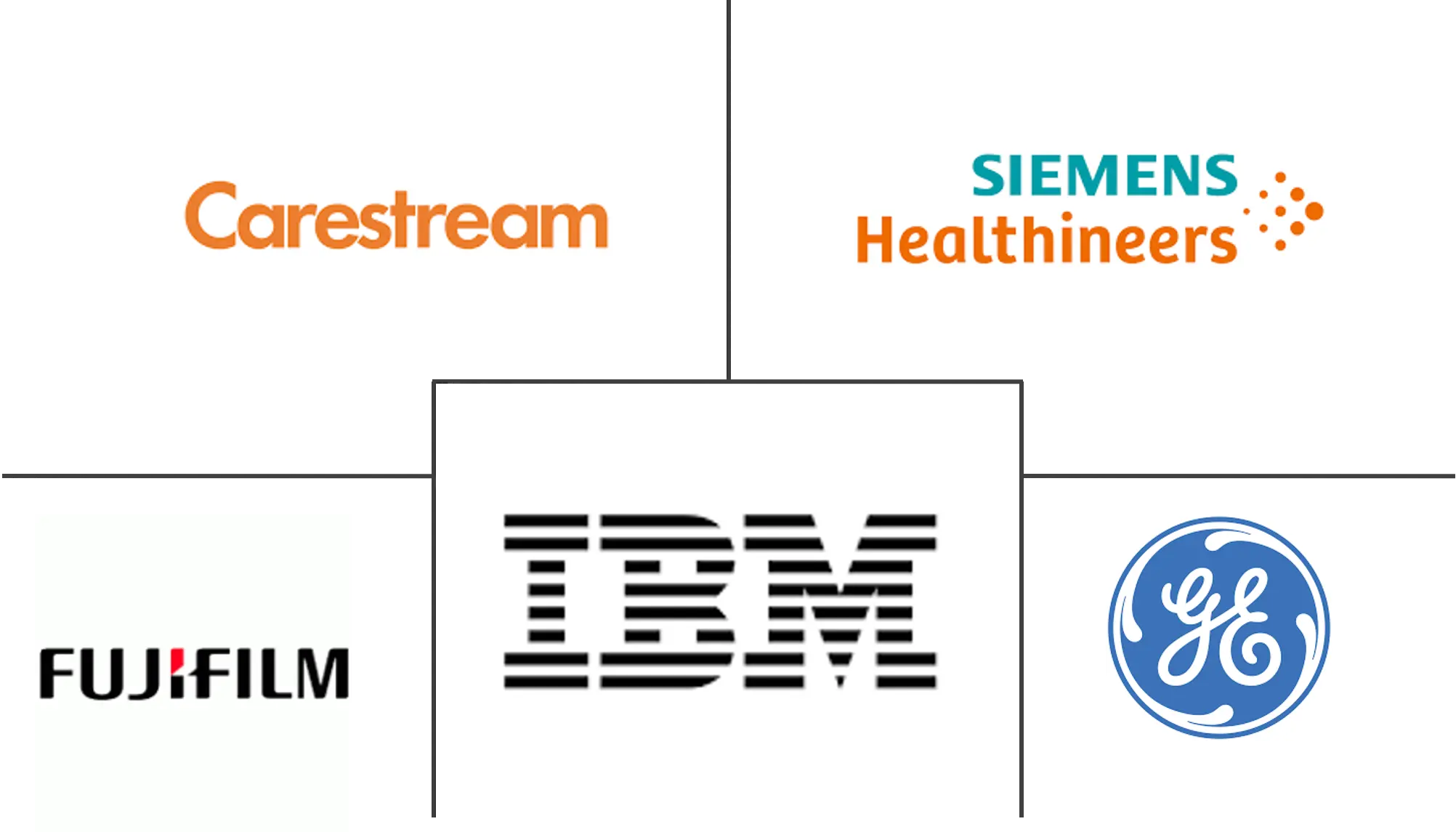Market Size of Medical Imaging Management Industry

| Study Period | 2019 - 2029 |
| Market Size (2024) | USD 4.59 Billion |
| Market Size (2029) | USD 6.43 Billion |
| CAGR (2024 - 2029) | 6.96 % |
| Fastest Growing Market | Asia Pacific |
| Largest Market | North America |
Major Players
*Disclaimer: Major Players sorted in no particular order |
Medical Image Management Market Analysis
The Medical Imaging Management Market size is estimated at USD 4.59 billion in 2024, and is expected to reach USD 6.43 billion by 2029, growing at a CAGR of 6.96% during the forecast period (2024-2029).
COVID-19 had a significant impact on the growth of the market over the pandemic period. This was mainly due to the high demand for medical imaging in the diagnosis of COVID-19, which in turn impacted the demand for medical imaging management. For instance, the Europe PMC article published in May 2021 mentioned that medical imaging played an essential role in the diagnosis, management, and disease progression surveillance of COVID-19 disease. The report also mentioned that chest radiography and computed tomography are commonly used imaging techniques globally during the pandemic. Thus, the COVID-19 outbreak had a notable impact on medical imaging management owing to the increased usage of medical imaging and management for the diagnosis of the disease. In addition, the demand for medical imaging management is expected to remain intact due to the emergence of mutant strains of SARS-CoV-2 and the rising demand for effective diagnosis and management, thereby contributing to the market's growth.
The increasing geriatric population, coupled with the rising prevalence of chronic diseases among the global population, is expected to drive the demand for medical imaging management, thereby propelling the market's growth.
For instance, the British Heart Foundation (BHF) data published in January 2022 reported that in 2021, the most common heart conditions affected globally were coronary (ischemic) heart disease (global prevalence estimated at 200 million), peripheral arterial (vascular) disease (110 million), stroke (100 million) and atrial fibrillation (60 million). The report also mentioned that the prevalence of heart and circulatory diseases in North America was 46 million, in Europe 99 million, in Africa 58 million, in South America 32 million, in Asia and Australia 310 million. As per the World Health Organization factsheet published in February 2022, in 2021, there were an estimated 1.9 million new cancer cases diagnosed in the United States. The report also mentioned that each year, approximately 400,000 children develop cancer globally. Cervical cancer is the most common in 23 countries, such as Eswatini, India, South Africa, Latin America, and others. Such increasing prevalence of various chronic diseases among the global population is expected to drive the demand for effective medical imaging, thereby driving the growth of the market.
Additionally, the report published by the UN in 2022 mentioned that the share of the global population aged 65 years or above is projected to rise from 10% in 2022 to 16% in 2050. Such an increasing geriatric population who are susceptible to developing chronic disorders is also expected to boost the demand for medical imaging management, thereby propelling the growth of the market.
On the other hand, the increasing product developments by various key market players are also expected to contribute to the market's growth. For instance, in August 2021, RamSoft, launched Omega AI VNA, a vendor-neutral archive that enables the seamless exchange of images and imaging data across healthcare enterprises. Omega AI VNA consolidates images and data from any system to allow clinicians to see the complete picture of a patient's medical history.
However, factors such as the cost associated with the implementation of medical imaging management solutions and a decrease in the supply of SPECT and PET systems due to the shortage of radioisotopes are expected to restrain the growth of the market over the forecast period.
Medical Image Management Industry Segmentation
As per the scope of the report, medical imaging management includes the fusion of a variety of information systems. With the help of these systems, healthcare providers can easily cope with radiology, nuclear medicine, and other related departments.
The Medical Imaging Management Market is segmented by System (Vendor Neutral Archive, Picture Archiving, and Communications System (PACS) and Other Systems), End-User (Hospitals, Diagnostic Centers, and Ambulatory Surgery Centers), and Geography (North America, Europe, Asia-Pacific, Middle-East and Africa, and South America). The market report also covers the estimated market sizes and trends for 17 countries across major regions globally. The report offers the value (USD million) for the above segments.
| By System | |
| Vendor Neutral Archive | |
| Picture Archiving and Communications System (PACS) | |
| Other Systems |
| By End-User | |
| Hospitals | |
| Diagnostic Centers | |
| Ambulatory Surgery Centers |
| Geography | ||||||||
| ||||||||
| ||||||||
| ||||||||
| ||||||||
|
Medical Imaging Management Market Size Summary
The Medical Image Management Market is poised for significant growth, driven by the increasing demand for effective diagnostic solutions and the rising prevalence of chronic diseases globally. The market's expansion is further fueled by the aging population, which is more susceptible to chronic disorders, thereby boosting the need for advanced medical imaging management systems. The COVID-19 pandemic has also played a pivotal role in accelerating market growth, as the demand for medical imaging surged for the diagnosis and management of the virus. This trend is expected to continue with the emergence of new variants, sustaining the demand for robust imaging management solutions. Additionally, technological advancements and product developments by key market players, such as the introduction of vendor-neutral archives and cloud-based systems, are enhancing the efficiency and effectiveness of medical imaging processes, contributing to market growth.
North America is anticipated to experience lucrative growth in the medical imaging management market, driven by the universalization of medical image archiving and the compatibility of advanced systems with existing data archival solutions. The region's growth is further supported by strategic partnerships and collaborations among market players and healthcare providers, aimed at improving imaging capabilities and workflow efficiency. The market is moderately competitive, with major global players like Carestream Health, Fujifilm Holdings, IBM Corporation, Siemens Healthineers, and GE Healthcare leading the charge. These companies are actively engaging in strategic initiatives, such as mergers, acquisitions, and product launches, to enhance their market presence and drive innovation in medical imaging management solutions.
Medical Imaging Management Market Size - Table of Contents
-
1. MARKET DYNAMICS
-
1.1 Market Overview
-
1.2 Market Drivers
-
1.2.1 Technological Innovations in the Diagnostic Imaging and Image Management
-
1.2.2 Rising Prevalence of Chronic Diseases
-
1.2.3 Emergence of Big Data in Healthcare
-
-
1.3 Market Restraints
-
1.3.1 Cost Associated With Implementation of Medical Imaging Management Solutions
-
1.3.2 Decrease In the Supply of SPECT and PET Systems due to the Shortage of Radioisotopes
-
-
1.4 Porter's Five Force Analysis
-
1.4.1 Threat of New Entrants
-
1.4.2 Bargaining Power of Buyers/Consumers
-
1.4.3 Bargaining Power of Suppliers
-
1.4.4 Threat of Substitute Products
-
1.4.5 Intensity of Competitive Rivalry
-
-
-
2. MARKET SEGMENTATION (Market Size by Value - USD million)
-
2.1 By System
-
2.1.1 Vendor Neutral Archive
-
2.1.2 Picture Archiving and Communications System (PACS)
-
2.1.3 Other Systems
-
-
2.2 By End-User
-
2.2.1 Hospitals
-
2.2.2 Diagnostic Centers
-
2.2.3 Ambulatory Surgery Centers
-
-
2.3 Geography
-
2.3.1 North America
-
2.3.1.1 United States
-
2.3.1.2 Canada
-
2.3.1.3 Mexico
-
-
2.3.2 Europe
-
2.3.2.1 Germany
-
2.3.2.2 United Kingdom
-
2.3.2.3 France
-
2.3.2.4 Italy
-
2.3.2.5 Spain
-
2.3.2.6 Rest of Europe
-
-
2.3.3 Asia-Pacific
-
2.3.3.1 China
-
2.3.3.2 Japan
-
2.3.3.3 India
-
2.3.3.4 Australia
-
2.3.3.5 South Korea
-
2.3.3.6 Rest of Asia-Pacific
-
-
2.3.4 Middle East and Africa
-
2.3.4.1 GCC
-
2.3.4.2 South Africa
-
2.3.4.3 Rest of Middle East and Africa
-
-
2.3.5 South America
-
2.3.5.1 Brazil
-
2.3.5.2 Argentina
-
2.3.5.3 Rest of South America
-
-
-
Medical Imaging Management Market Size FAQs
How big is the Medical Imaging Management Market?
The Medical Imaging Management Market size is expected to reach USD 4.59 billion in 2024 and grow at a CAGR of 6.96% to reach USD 6.43 billion by 2029.
What is the current Medical Imaging Management Market size?
In 2024, the Medical Imaging Management Market size is expected to reach USD 4.59 billion.

